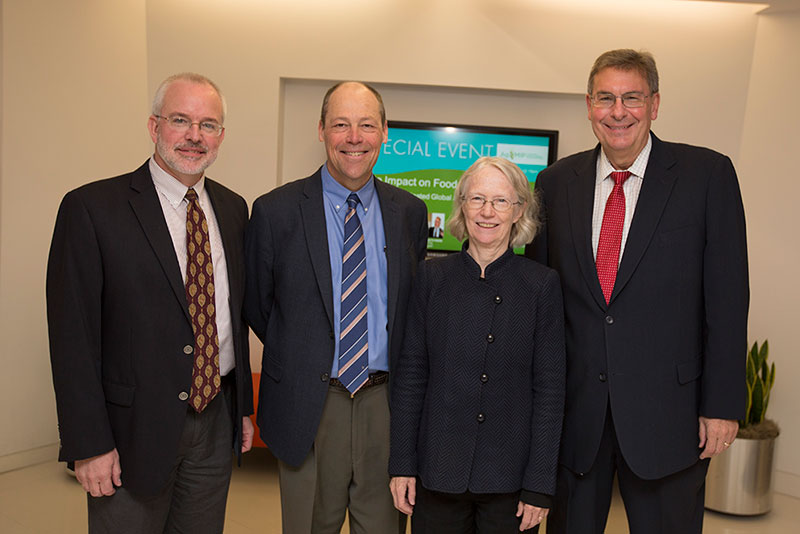Photo: IFPRI
Pictured (L-R): Keith Wiebe (IFPRI), John Antle (Oregon State University), Cynthia E. Rosenzweig (NASA Goddard Institute for Space Studies), and Mark Rosegrant (IFPRI)
By James Oliver and Greg Reppucci
The International Food Policy Research Institute (IFPRI) hosted a special event, Climate Impact on Food and Nutrition Systems: Coordinated Global and Regional Assessments, on Monday, April 11th 2016 featuring a panel of experts from the Agricultural Model Intercomparison and Improvement Project (AgMIP). Panel members AgMIP Co-Principal Investigators, Cynthia Rosenzweig and John Antle, along with IFPRI senior research scientist and AgMIP global economics co-leader, Keith Wiebe presented the latest efforts of AgMIP including a new initiative, Coordinated Global and Regional Assessments (CGRA), followed by questions from the audience.
AgMIP is a worldwide community of scientists focusing on improving the characterization of food security due to climate change and other factors. CGRA is one of the first efforts to focus on melding together differing disciplines and scales to develop a more consistent and complete assessment of food security.
In her presentation Rosenzweig stressed the importance of coordinating work on both the regional and global scale, and how, through collaboration, the modeling community is able to improve and advance modeling capability. Rosenzweig also emphasized how essential it is to use an ensemble of models across different scales in order to produce the best overall output.
Assessments comprising an ensemble of models, compared to site-specific field data, showed the strength of collaboration. “What we found from using the ensembles is that the ensemble of models predicted the yields accurately. Most individual models could not predict accurately across all individual sites,” Rosenzweig concluded.
In his presentation John Antle explained that regionally stakeholders understand climate is changing and that certain impacts are unavoidable. Stakeholders want to know what action they should take to help lessen negative impact. “We need to move from assessment to understanding what kind of real actions can be taken,” he said.
Continuous and effective stakeholder interaction is vital to a complete food security assessment. Antle presented a demonstration of this concept in AgMIP’s research in Zimbabwe. The researchers followed an iterative process in developing transformative scenarios after a series of meetings with stakeholders in the region.
“AgMIP’s methods add a new dimension of vulnerability to impact assessments,” continued Antle. “We can’t assume Africa will be the same in mid-century as it is today. Economic conditions and of course farm size, household size, policy, infrastructure investment; all of those factors are going to dramatically change the story the more we look out into the future and try to understand the possible vulnerabilities and potential for adaptation to climate.”
Keith Wiebe then presented the process of modeling food security by combining inputs from different sources. Climate model outputs, constructed through the use of representative concentration pathways (RCPs), are inputted into the biophysical models. The biophysical outputs are then inputted into the global economic models in conjunction with the shared socioeconomic pathways (SSPs). This ultimately provides a series of indicators that can then be used for projecting global and regional changes.

Slide: Keith Wiebe
Wiebe showed the results from an ensemble of five global economic models for different commodities that projected climate change impacts for the year 2050. “With climate change we see the potential for quite significant environmental impact as a result of increased land use and change and potentially quite significant food security impacts as prices are projected to increase, “ he explained.
Food security and health could be negatively impacted by climate change in 2050 Wiebe concluded, especially in Africa where the population has climate risk factors such as an underweight population and malnutrition. The work of AgMIP in linking the global and regional models will help strengthen both assessments. The goal is not a single mega model but a set of complementary tools for different scales, Wiebe concluded.
Following the presentations the panel addressed questions from the audience moderated by Mark Rosegrant, Division Director of the Environment and Production Technology Division at IFPRI. Questions included the inclusion of livestock in the assessments, links to policy recommendations, upcoming IPCC special reports, strategies for managing risk, inclusion of nutrients, among others.
To see the full recordings and presentations from the special event go to the IFPRI website here.

